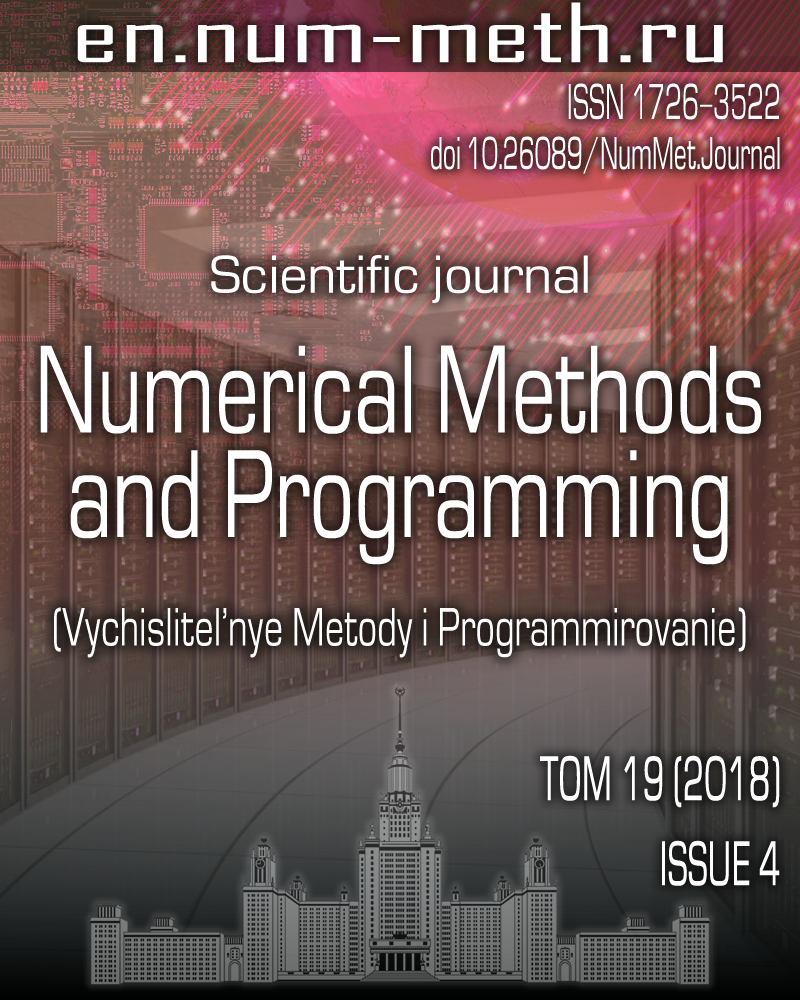DOI: https://doi.org/10.26089/NumMet.v19r442
A method of dynamic programming in the problems of optimal panel deformation in the creep mode
Keywords:
Abstract
The problems of modeling the panel forming processes in the creep mode with the aid of a reconfigurable rod punch are considered. The problem of deformation in creep with consideration of geometric nonlinearity and contact conditions is solved by the finite element method. The experimental results allow one to identify the effect of scattering with the damage parameter. In this case, the forming processes allow controlling the level of material damage and coordinating with technological constraints due to the optimal choice of the strain path in time. A discrete optimal control problem is formulated and is solved by the method of dynamic programming with the refinement of the solution by the method of local variations. The efficiency of the proposed method is shown in comparison with a full search of variants for the strain paths.
Published
Issue
Section
References
- V. A. Portnoy and A. V. Portnoy, “On Rational Design of Stable Integral Panels,” Vestn. Tupolev Gos. Tekh. Univ., No. 2, 9-13 (2006).
- S. N. Verichev, B. V. Gorev, and I. A. Banshchikova, “The Shaping by Bending of Elements Aircraft Structures at Plasticity Conditions,” Obrabotka Metallov, No. 4, 85-93 (2014).
- B. D. Annin, A. I. Oleinikov, and K. S. Bormotin, “Modeling of Forming of Wing Panels of the SSJ-100 Aircraft,” Zh. Prikl. Mekh. Tekh. Fiz. 51 (4), 155-165 (2010) [J. Appl. Mech. Tech. Phys. 51 (4), 579-589 (2010)].
- O. V. Sosnin, A. F. Nikitenko, and B. V. Gorev, “Justification of the Energy Variant of the Theory of Creep and Long-Term Strength of Metals,” Zh. Prikl. Mekh. Tekh. Fiz. 51 (4), 188-197 (2010) [J. Appl. Mech. Tech. Phys. 51 (4), 608-614 (2010)].
- D. F. Walczyk, J. Lakshmikanthan, and D. R. Kirk, “Development of a Reconfigurable Tool for Forming Aircraft Body Panels,” J. Manuf. Syst. 17 (4), 287-296 (1998).
- D. F. Walczyk and D. E. Hardt, “Design and Analysis of Reconfigurable Discrete Dies for Sheet Metal Forming,” J. Manuf. Syst. 17 (6), 436-454 (1998).
- E. Haas, R. C. Schwarz, and J. M. Papazian, “Design and Test of a Reconfigurable Forming Die,” J. Manuf. Process. 4 (1), 77-85 (2002).
- D. Simon, L. Kern, J. Wagner, and G. Reinhart, “A Reconfigurable Tooling System for Producing Plastic Shields,” Procedia CIRP 17, 853-858 (2014).
- S. Z. Su, M. Z. Li, C. G. Liu, et al., “Flexible Tooling System Using Reconfigurable Multi-Point Thermoforming Technology for Manufacturing Freeform Panels,” Key Eng. Mater. 504-506}, 839-844 (2012).
- K. S. Bormotin, “Iterative Method for Solving Geometrically Nonlinear Inverse Problems of Structural Element Shaping under Creep Conditions,” Zh. Vychisl. Mat. Mat. Fiz. 53 (12), 2091-2099 (2013) [Comput. Math. Math. Phys. 53 (12), 1908-1915 (2013)].
- K. S. Bormotin, S. V. Belykh, and Win Aung, “Mathematical Modeling of Inverse Multipoint Forming Problems in the Creep Mode Using a Reconfigurable Tool,” Vychisl. Metody Programm. 17, 258-267 (2016).
- K. S. Bormotin, “A Method for Solving Inverse Problems of Inelastic Deformation of Thin-Walled Panels,” Vychisl. Metody Programm. 18, 359-370 (2017).
- K. Bormotin, S. Belykh, and Win Aung, “Simulation and Estimation of Parameters in Reconfigurable Multipoint Forming Processes of Plates in the Creep Mode,” MATEC Web Conf. 129 (2017).
doi 10.1051/matecconf/201712905004 - I. Yu. Tsvelodub, A Stability Postulate and Its Applications in the Theory of Creep for Metallic Materials (Hydrodynamics Inst., Novosibirsk, 1991) [in Russian].
- K. S. Bormotin and A. I. Oleinikov, “Variational Principles and Optimal Solutions of the Inverse Problems of Creep Bending of Plates,” Zh. Prikl. Mekh. Tekh. Fiz. 53 (5), 136-146 (2012) [J. Appl. Mech. Tech. Phys. 53 (5), 751-760 (2012)].
- P. Wriggers, Computational Contact Mechanics (Springer, Berlin, 2006).
- S. N. Korobeinikov, Nonlinear Deformation of Solids (Izd. Ross. Akad. Nauk, Novosibirsk, 2000) [in Russian].
- K.-J. Bathe, Finite Element Procedures (Prentice Hall, Upper Saddle River, 1982).
- Marc: Advanced Nonlinear Simulation Solution, MSC.Software Corporation.
http://www.mscsoftware.com/product/marc . Cited November 8, 2018. - F. P. Vasil’ev, Methods of Optimization (Faktorial Press, Moscow, 2002) [in Russian].
- N. N. Moiseev, Elements of the Theory of Optimal Systems (Nauka, Moscow, 1975) [in Russian].


